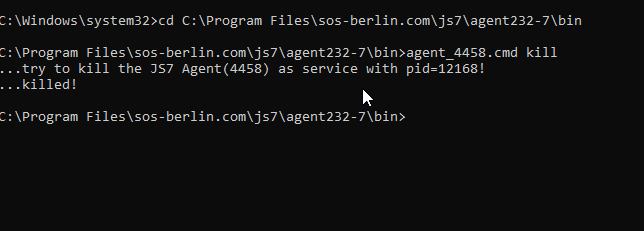Introduction
Using a JS7 - Agent Cluster provides high availability and is a feature that is subject to the JS7 - License.
- Fail-over is an automated operation that occurs when a Subagent is aborted or killed. Fail-over is applied in case of abnormal termination.
For command-line references see the JS7 - Agent - Command Line Operation article.
Test Case for the Agent Cluster
In the Article JS7 - How to set up an Agent Cluster we have set up the Agent cluster with multiple subagents.
- Create a workflow from the configuration and assigned the same Agent Cluster to all the jobs. Once the configuration is completed deploy the workflow.
- The Agent cluster is configured as a round-robin and executes each next job on the next Subagent.
- To test this switch to the Workflows tab and select the workflow from the folder tree structure.
- Expand the workflow and add order.
- Once the workflow executes successfully open the order history from the order history view.
- In the log, you can see that all the jobs use different SubAgents as we use a round-robin Agent Cluster. Each next job executes on the next Subagent.
Fail-over
Fail-over occurs when an Active Subagent is terminated abnormally. Fail-over means that the task currently being executed by the Subagent is considered to have failed and that the related order is set to a failed state. An Inactive Subagent is no longer considered for execution of jobs by a Director Agent.
Fail-over can be invoked by the following actions:
- The Active Subagent is killed, for example:
- for Unix with a SIGKILL signal corresponding to the command:
kill -9 - for Windows with the command:
taskkill /F
- for Unix with a SIGKILL signal corresponding to the command:
- From the command line the user performs one of the operations:
agent.sh | .cmd abortagent.sh | .cmd kill
Fail-over will not occur when:
- the Active Subagent is stopped normally from the command line:
agent.sh | .cmd stop
- the operating system is shut down and
systemd/init.dor a Windows Service are in place to stop the Subagent normally.
Fail-over happens within a short period of time, typically in 2-3s.
How to test fail-over in the Agent Cluster
In the Article JS7 - How to set up an Agent Cluster we have set up the Agent cluster with multiple subagents.
- Create a workflow from the configuration and assigned the same Agent Cluster to all the jobs. Once the configuration is completed deploy the workflow.
- The Agent cluster is configured as a round-robin and executes each next job on the next Subagent.
- To test this switch to the Workflows tab and select the workflow from the folder tree structure.
- Expand the workflow and add order.
- Kill any of the SubAgent from the windows command line or from the Linux terminal to execute the fail-over test case with the below command.
- The Active Subagent is killed, for example:
- for Unix with a SIGKILL signal corresponding to the command:
kill -9 - for Windows with the command:
taskkill /F
- for Unix with a SIGKILL signal corresponding to the command:
- From the command line the user performs one of the operations:
agent.sh | .cmd abortagent.sh | .cmd kill
- The Active Subagent is killed, for example:






